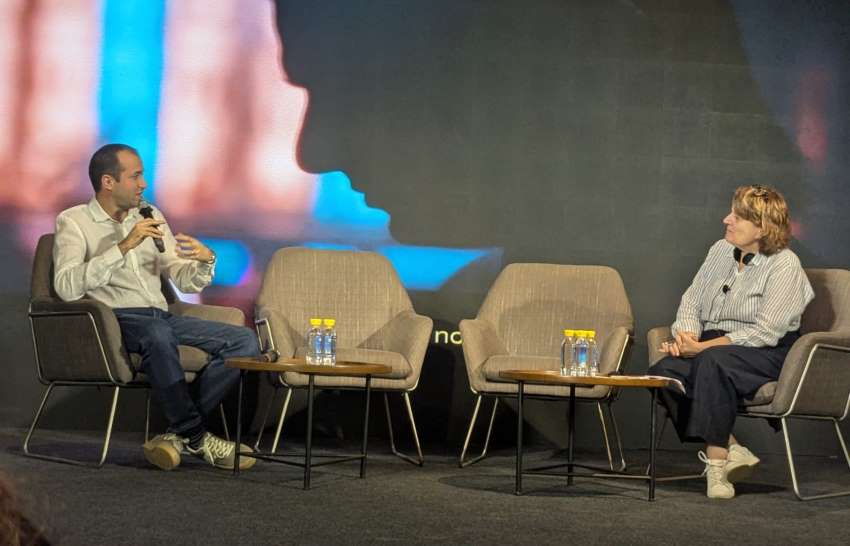FW
The 5th edition of Intex South Asia was a remarkable success with over 3,900 international buyers from over 13 countries attending it. The event was held from November 13-15, 2019, at the Sirimavo Bandaranaike Memorial Exhibition Centre (BMICH) in Colombo, Sri Lanka.
The three-day fair connected these buyers with over 220 quality suppliers from over 13 countries showcasing yarns, apparel fabrics, denim fabrics, clothing accessories and allied services, dyes and chemicals at the biggest international apparel textile sourcing show in the South Asian region.
As the largest trade fair of its kind in the region, Intex South Asia welcomed leading and quality textile suppliers from India, Sri Lanka, Pakistan, Bangladesh, China, Taiwan, There were country pavilions from India with 80+ companies, China with 60+ companies, Indonesia Textile Pavilion with 5 companies, Korea Textiles Showcase Pavilion with 28 companies and Taiwan Textiles Showcase Pavilion with 8 companies.
The host country industry representatives such as Brandix, MAS, Hirdaramani, Timex, Star Garments, Emjay International, EAM Maliban, KASH Garments, Marks & Spencer, TESCO, H&M, NEXT UK, Decathalon, George, ASMARA, MGF Sourcing, Regal Calibre, etc. attended the show in large numbers with their sourcing, merchandising and design teams. Overall, the show was attended by 3,920+ leading apparel exporters, sourcing offices, brands & retailers, indenting agents, e-tailers and others from 20+ countries and regions who came to Intex South Asia looking for new products, new suppliers and to gain market intelligence & explore new business and sourcing opportunities in Sri Lanka and other international markets.
Intex South Asia also organised a panel discussion on “Materials, Sustainability & Circularity” which saw top industry leaders from across the region present their views on sustainability processes of the industry in South Asia.
Intex South Asia’s ‘Interactive Business Forums’ always deliver high quality market intelligence to support industry efforts to upgrade, move up the value chain, and better understand intra- regional trade to help manufacturers gain a competitive edge.
This year’s ‘Interactive Business Forum’ was a huge success where for the first time, Cotton Council International (CCI) - also known as Cotton USA - which is the export promotion arm of the National Cotton Council of America (NCC) brough to Sri Lanka the latest in research, highlighting new ideas in technology, fashion, blends, processes, etc. Also presenting for the 1st time at Intex South Asia was ‘Fashion for Good’, providing insights on “Trends & Technological
Textile Innovations; Driving Sustainability in the Textile Value Chain” and its South Asia programme. In the third and last session, the ‘Better Cotton Initiative’ highlighted “Sustainability in Textiles” for a clearer understanding of environmental, social and economic sustainability.
The Q & A interaction afterwards was quite encouraging for the industry professionals (domestic as well as international) who attended the event in large numbers.
The ‘Networking Reception’ organised by Intex South Asia was an event where high-level interactions took place in a relaxed and informal atmosphere. The organisers took this opportunity to celebrate the 5th Edition of their show by felicitating their long term support partners in industry as well as the Boards and Associations through whose support Intex South Asia has grown to become the largest international apparel sourcing show in the region.
By the end of the 5th edition, it was 20% growth recorded in the buyers’ footfall and 15% increase in exhibitors as compared to last year.
India’s new textile policy will envisage positioning the country as a fully integrated, globally-competitive manufacturing and exporting hub. The 10 year policy will entail the strategy and action plan for the country's textile and apparel sector. The formulation of the new policy has been under consideration for some time now. It envisages the creation of an additional 35 million jobs.
The existing textile policy was framed about 13 years ago. Since then, the industry has undergone various changes on the domestic and international front. The domestic textile industry has seen large-scale modernisation and technological upgradation in the last decade and faces new challenges.
India has set up institutional mechanisms to enable the textile industry achieve its full potential of production, exports and employment. One is a Knowledge Network Management System (KNMS) which will facilitate exchange of knowledge between academia, the farming community and the industry on the productivity of natural fibers and diversification of their by-products. The KNMS will cover jute, silk, wool and cotton. Another is a synergy group on manmade fibers which will formulate policy interventions to enhance the growth and competitiveness of the manmade fiber industry in India. India has a great chance to capture the market for manmade fibers that’s been vacated by China.
Swiss textile innovator HeiQ has added bio-based thermo-functional polymer products to its HeiQ Smart Temp family for a full range of intelligent thermoregulation triggered by body heat. The newly introduced products add dual-action cooling at contact to the already successful dynamic evaporative cooling technology.
Launched in 2011, HeiQ Smart Temp was a pioneer in intelligent thermoregulation technology for textiles. Continuous refinements of this product range have allowed HeiQ to be the go-to solution provider as its technologies offer not only industry-leading dynamic evaporative cooling performance, but also ease of application and a friendly price point for brand partners. The latest breakthrough with cool touch technology allows consumers to touch, feel and understand the technology at point-of-sale, and ensures thermal comfort at all times by providing the benefits of cool at contact and continuous evaporative cooling. It is currently optimized for use on home textile products such as mattress ticking and bed linens.
There are three new products in the range that all provide instant cooling from a bio-based thermo-functional polymer, and each product is optimized to perform on specific items such as mattress ticking or bedding accessories. By adding a new category of products to the range, HeiQ now has a broad range of intelligent thermoregulation solutions for the home textile market.
Asia Pacific Rayon is the first integrated fiber manufacturer in Indonesia that has the capabilities to produce viscose based on wood derived from sustainably-managed plantations. Trees are harvested within five years for the next cycle of planting and harvesting. Targeting both domestic and international markets, the company’s production across the entire value chain -- from raw materials to resources, technology and design creation – takes place in the country.
Viscose is the third most commonly used fiber in the world. Viscose has been hailed as a sustainable alternative to oil-based synthetic textiles such as polyester, acrylic, nylon and spandex.
Introduced in the late1800s as an alternative to silk, the plant-based fiber, also known as rayon, is inexpensive to make and applicable in many ways, including for casual wear items, denim, socks, bed linen, towels, face masks and wet wipes. Viscose wrinkles easily and may shrink when washed, but it boasts great qualities as well, including being soft, smooth, lightweight and breathable, featuring excellent color retention and absorbency, draping well and being versatile by blending nicely with other fibers.
Globally, China leads the market of viscose fiber producing countries, with India and Indonesia following behind in second and third position.
Complementary trade shows, Panorama Berlin, Selvedge Run and Zeitgeist are relocating from Messe Berlin to Tempelhof Airport beginning from the upcoming January 14 to 16, 2020 event. The new venue is the former home to the now defunct Bread & Butter trade show and serves as an event space for Berlin Fashion Week.
With the theme ‘Rebel with a Cause,’ the trade events aim to trudge along with a same old, same old’ attitude with unconventional formats. As traditional retail takes a hit with e-commerce, social media and resale, the show offers space to brands that dare to challenge established structures and that understand the importance of value-oriented consumer behavior. They essentially recreate concepts that work at retail for the trade.
Panorama will introduce a pop-up format that will include modular brand pavilions customized by the brands. The event will give brands opportunity to showcase their products in an innovative setting with the focus clearly on the product, brand and storytelling.
Organisers of these trade shows also plan to evolve the concept during the July 2020 event by taking the mobile fashion pop-up” to high traffic areas in the city, complete with limited-edition products, drops and parties.
Jesper Magnunsson will now head of global leasing for H&M. Magnunsson, who has worked for the Swedish company for more than 10 years, was head of leasing in Hong Kong, Taiwan and Macau, as well as head of global expansion of new business and franchises of the chain.
The company is in the middle of a reorganization process and has tried new formats like rental with its COS chain in China and its new store in Berlin that focuses on its local market. On a global scale, H&M’s revenue for the fiscal year 2019 was up eleven per cent. In the fourth quarter, H&M sales increased by nine per cent, partially weighed down by calendar effects.
The fashion retailer is on course to increase annual profits for the first time in four years following heavy investment in online and other services to adapt to a changing market. Over the past few years the Swedish-based retailer has invested in online services, new store concepts and independent brands to broaden its customer base and turn itself around. Germany is H&M's biggest market. The group has embarked on a road to recovery after slowing footfall at its core H&M-branded stores caused years of sliding group profits, mounting inventories and shrinking market value.
Bangladesh RMG exports to major non-traditional markets witnessed a negative growth of 6.61 per cent during the first five months of FY 2019-20 Export of apparel items to non-traditional markets, including 11 prospective ones and excepting India, Korea and Mexico, witnessed a negative growth, Bangladesh Garment Manufacturers and Exporters Association (BGMEA) data revealed.
Bangladeshi RMG sector earned $ 2.24 billion from the non-traditional markets during July-November period of FY 20, which was $2.40 billion in the corresponding period of last fiscal. Export to Brazil, China, South Africa and Turkey witnessed a negative growth of 34.12 per cent, 21.47 per cent, 19.47 per cent and 34.92 per cent respectively during the period. RMG export declined by 7.17 per cent, 4.50 per cent and 2.74 per cent to Australia, Japan and Russia respectively, while it fell by less than 1.0 per cent in Chile during the first five months of current FY, data showed.
The non-traditional markets accounted for 16.66 per cent or $5.68 billion of the country's total garment export volume worth $34.13 billion in FY 19. Export receipts from the non-traditional markets witnessed a 21.77 per cent growth in last FY. More than 76 per cent of the earning from the non-traditional markets came from these 11 potential ones.
The RMG export in traditional markets - the EU, the US and Canada - also fell by 8.51 per cent, 5.17 per cent and 13.15 per cent respectively during July-November period of FY 20.
The India Business of Fashion Report study released recently predicts, Indian apparel market is expected to grow by nearly 11 per cent to reach $ 85 billion by 2021. The Indian apparel market, pegged at around $65 billion, is the second largest retail market after food and grocery in India. It grew at a CAGR of 11.5 per cent in the period from 2012-17 and is expected to grow at nearly 11 per cent CAGR in 2017-21 period to reach a value of $85 billion by 2021.
These estimates are part of a study by Rajat Wahi, Partner, Deloitte India study, titled 'Apparel and fashion industry and the importance of innovation and sustainability' for the report. The report further illustrates that the country's fashion market is majorly driven by key growth drivers, including young demographics, rising urbanisation, increasing affluence and a growing middle income segment, greater brand awareness, better accessibility and availability and increased formalisation of the sector.
"Upcoming menswear fashion show Milano Moda Uomo will showcase 77 collections this year compared to 56 last year. The event will be held from January 10-14, 2019. Luxury fashion brand Prada will present a collection once again at the event after showing in Shanghai in June."
 Upcoming menswear fashion show Milano Moda Uomo will showcase 77 collections this year compared to 56 last year. The event will be held from January 10-14, 2019. Luxury fashion brand Prada will present a collection once again at the event after showing in Shanghai in June.
Upcoming menswear fashion show Milano Moda Uomo will showcase 77 collections this year compared to 56 last year. The event will be held from January 10-14, 2019. Luxury fashion brand Prada will present a collection once again at the event after showing in Shanghai in June.
Along with Confartiginia to Imprese and the Ministry of Economic Sviluppo and Ice Agenzia, the Camera Nazionale della Moda Italiana will present a new improvement plan for the Milan Men’s Fashion Week.
Agenzia, the Camera Nazionale della Moda Italiana will present a new improvement plan for the Milan Men’s Fashion Week.
The project will present Milan and Italy as international fashion hubs, giving space to small and medium companies and presenting to the world Italian know-how; starting in Florence with Pitti and also Milan Fashion Week. It will give the Camera Nazionale della Moda Italiana, the opportunity to expand the event on an international platform.
Indian readymade garment exports fell more than six per cent in November 2019 as compared to the previous year. This was due to the delay in disbursements under the Rebate of State and Central Taxes and Levies Scheme ((ROSCTL) and the Merchandise Exports from India Scheme (MEIS), exporters are facing a severe cash crunch and are not able to compete with garment manufacturers of other countries who have various advantages. Reimbursements worth over Rs 5,000 crores are pending.
Indian exports are not competitive. Textiles from India are around 10 per cent costlier than textiles from other countries. Also Bangladesh, Sri Lanka and Vietnam have low production costs and their exporters enjoy preferential duty access to key markets. In comparison Indian exporters face higher trade barriers in the US and the European Union. Bangladesh’s exports to the EU face zero per cent tariff and exports to the US face 3.9 per cent tariff. Indian textile exports face six per cent tariff in the EU and 6.2 per cent tariff in the US. In an attempt to counter subdued exports, Indian readymade garment exporters are creating modalities to make a portal or a central database, where they can list their products according to categories to assist buyers.












